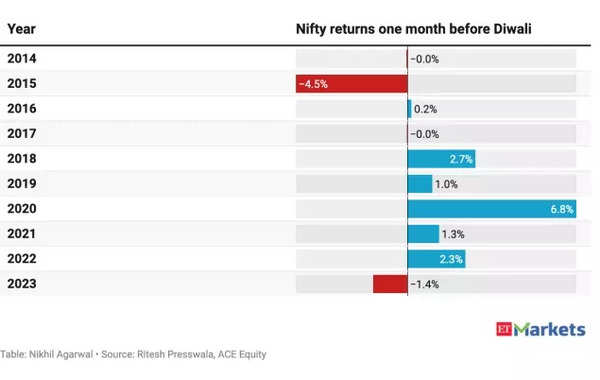No fireworks from Sensex this Diwali! The Indian stock market has been experiencing a significant downturn, with the Nifty falling nearly 6% and the Sensex losing over 4,800 points in the last month. This October has been particularly harsh for investors, marking the worst month since the Covid-induced crash and the most disappointing pre-Diwali period in a decade.
As the market’s focus shifts from momentum to quality and FII outflows persist, the trading strategy has changed from buying on dips to selling on rallies. Analysts predict that this trend may continue until there are clear indications of growth in consumption and earnings.
Since 2014, the Nifty has only seen four instances of negative returns in the month leading up to Diwali, with an average return of 0.84%, according to an ET report. The worst pre-Diwali phase for Nifty was in 2015 when it fell 4.45%. Last year, the index fell 1.36%, and this year, it appears to be on track to surpass the 2015 record.
Also Read | ‘Mr Modi is fantastic…’: Prem Watsa, known as ‘Canada’s Warren Buffett’, says India can grow at 10% under PM Modi
“The consensus for earnings growth for Nifty50 is barely in double digits. If earnings disappoint even these undemanding expectations could emerge as a key reason for market correction,” Sorbh Gupta, Senior Fund Manager – Equities, Bajaj Finserv AMC, told ET.
Following a downgrade by Bernstein’s quant strategists, Goldman Sachs also downgraded India from overweight to neutral this week, citing slowing economic growth as the reason.

Stock Market Trend Before Diwali Over Years
The market is now closely watching whether retail investors can maintain their confidence in equities, as domestic flows have been a crucial counterbalance to FII outflows in recent times.
While FIIs have withdrawn Rs 86,000 crore from the market due to a shift towards China, concerns about high valuations in India, and weak earnings outlook, DIIs have invested Rs 93,000 crore.
For long-term bulls, the current correction presents a favorable entry point into the market, feel analysts.
Veteran investor Hemang Jani believes that the stock market is close to forming a bottom, although the exact timing remains uncertain. He expects the base formation to start within the next few days or weeks.
Also Read | Forget gold buying this festive season? Why you should consider silver for investment as prices cross Rs 1 lakh mark
The recent market correction has hit smaller stocks harder, particularly those popular among retail investors. For instance, Cochin Shipyard, a PSU defence stock, has fallen 52% from its 52-week high. Market experts caution that the froth in the broader market has not yet been completely cleared.
“One has to be specifically careful of companies with lower free float as these stocks can move sharply in either direction due to their limited liquidity. From a sector perspective, we still believe PSU, defence and some capex-driven businesses are still in the overvaluation zone,” Gupta said.
The stock market usually shows a positive bias during Diwali, as the auspicious occasion often aligns with optimism and renewed investor confidence. Amit Goel, Co-Founder and Chief Global Strategist at Pace 360, noted that this positive trend is not solely due to Diwali but also influenced by the corporate earnings season starting in October and global macro factors.
Over the past decade, the average return in the one month leading up to Diwali has been positive. Goel expects Indian equities to reclaim their all-time highs by the end of next month, given the country’s long-term growth story.
Recently, UBS recommended “buying the dip,” stating that the soft patch in India’s growth and earnings appears temporary.
Christopher Wood from Jefferies, known for his bullish stance on India in emerging market circles, believes that India remains the most attractive stock market for the next decade, primarily due to its earnings outlook.
